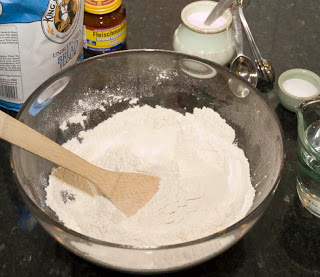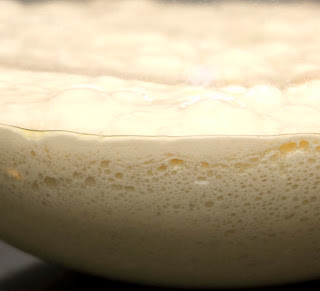
 Since Jim Lahey’s crusty white pot bread was published back in 2006, thousands of home baker’s have tried their hand baking this simple, but spectacularly good bread. I liked his version, but wanted to come up with a larger loaf and one that had even more flavor. And I wanted to completely eliminate the hand-shaping and all the kitchen counter mess.
Since Jim Lahey’s crusty white pot bread was published back in 2006, thousands of home baker’s have tried their hand baking this simple, but spectacularly good bread. I liked his version, but wanted to come up with a larger loaf and one that had even more flavor. And I wanted to completely eliminate the hand-shaping and all the kitchen counter mess.
That’s what I did with the recipe below. It’s in my new bread cookbook, Kneadlessly Simple. The very basic ingredients–just flour and a little yeast, salt, and sugar are mixed together in a large bowl. Then ice cold water is stirred in. Yes, ice cold! (Be sure you use fast-rising, instant, or bread machine yeast with the cold water though.) It won’t hurt the yeast and it improves the flavor and texture of the finished bread. As you can see, the dough is moist, but not wet like batter bread. It should hold some shape and be hard to stir.
 Next, the dough is covered and just sits and kneads itself. For convenience and the absolute best flavor, it can be refrigerated for a while. This is entirely optional. Then it goes on the countertop for a slow, cool rise of about 18 to 24 hours. A little more or less won’t hurt.
Next, the dough is covered and just sits and kneads itself. For convenience and the absolute best flavor, it can be refrigerated for a while. This is entirely optional. Then it goes on the countertop for a slow, cool rise of about 18 to 24 hours. A little more or less won’t hurt.
 It’s the natural bubbling action, caused by the yeast fermentation, that actually kneads the dough. The bubbles actually move the dough, bringing together the two proteins that form gluten on the molecular level in much the same way as the pulling and pushing of traditional kneading brings them together in a more obvious way. The long, slow rise also allows plenty of time for the dough to develop a rich aroma and complex flavor that can’t be achieved with a hurried rise.
It’s the natural bubbling action, caused by the yeast fermentation, that actually kneads the dough. The bubbles actually move the dough, bringing together the two proteins that form gluten on the molecular level in much the same way as the pulling and pushing of traditional kneading brings them together in a more obvious way. The long, slow rise also allows plenty of time for the dough to develop a rich aroma and complex flavor that can’t be achieved with a hurried rise.
 The next step is simply to fold the dough into its center until partially deflated, and after it rises again, invert it directly into a preheated 3 1/2 to 4-quart Dutch oven to bake. Absolutely no shaping of the loaf or other fiddling is required. The surface smooths out and the dough browns and forms a lovely boule on its own.
The next step is simply to fold the dough into its center until partially deflated, and after it rises again, invert it directly into a preheated 3 1/2 to 4-quart Dutch oven to bake. Absolutely no shaping of the loaf or other fiddling is required. The surface smooths out and the dough browns and forms a lovely boule on its own.
And finally there’s the bread, still warm from the oven and boasting a beautiful, crusty top and creamy-soft interior.
Pot boules — round, peasant-style breads that are simply popped into a sturdy, lidded pot and baked — are about the easiest loaves possible, but among the most gratifying. They puff up well, brown beautifully and always come out crusty, due to the moisture trapped inside the pot during the first few minutes in the oven. (In fact, the pot actually serves as a minioven.) Still, if you don’t have a pot, here’s a popular crusty cheese bread that just uses a loaf pan.

For another pot bread, my crusty seeded pale ale pot boule, go here. For one very economical pot I like a lot, go here; or lots of useful info on various kinds of pots to use, click here .
Like the basic black dress, this basic white loaf is always appropriate and in favor. The interplay of light mild crumb, crunchy golden crust and deep, sweet yeast taste and aroma (coaxed out by long, slow rising) is downright amazing. In fact, eating this bread is a far more complex and exciting sensory experience than one might expect from the simple ingredients.
If you’d like to listen to an interview of me and an NPR commentator making this bread in my kitchen click here .

Tip: A cast iron Dutch oven makes a good baking pot. The bread usually doesn’t stick to seasoned plain or enameled cast iron, but if you aren’t sure about your pot, spritz the interior with a little nonstick spray immediately before you turn out the dough into it.
Makes 1 large loaf, 12 to 14 slices.
4 cups (20 ounces) unbleached all-purpose white flour or white bread flour, plus more as needed
1 teaspoon granulated sugar
2 teaspoons table salt
3/4 teaspoon instant, fast-rising or bread-machine yeast
2 cups ice water, plus more if needed
Corn oil, canola oil or other flavorless vegetable oil or oil spray for coating dough
First Rise: In a large bowl, thoroughly stir together the flour, sugar, salt and yeast. Vigorously stir the water into the bowl, scraping down the sides and mixing until the ingredients are thoroughly blended. If the mixture is too dry to incorporate all the flour, stir in more water, a bit at a time, just enough to blend the ingredients. Don’t over-moisten; the dough should be very stiff. If necessary, stir in enough more flour to yield a hard-to-stir dough. Brush or spray the top with oil. Cover the bowl with plastic wrap. If desired, for best flavor or for convenience, you can refrigerate the dough for three to 10 hours. Then let rise at cool room temperature for 18 to 24 hours. If convenient, vigorously stir the dough once about halfway through the rise.
Second Rise: Using an oiled rubber spatula, gently lift and fold the dough in toward the center, all the way around, until mostly deflated; don’t stir. Brush or spray the surface with oil. Re-cover the bowl with plastic wrap that has been coated with nonstick spray. Let rise using any of these methods: for a 1 1/2- to 2 1/2-hour regular rise, let stand at warm room temperature; for a 1- to 2-hour accelerated rise, let stand in a turned-off microwave along with 1 cup of boiling-hot water; or for an extended rise, refrigerate, covered, for 4 to 24 hours, then set out at room temperature. Continue the rise until the dough doubles from the deflated size; remove the plastic if the dough nears it.
Baking Preliminaries: 20 minutes before baking time, put a rack in the lower third of the oven; preheat to 450 degrees. Heat a 3 1/2- to 4-quart (or larger) heavy metal pot or Dutch oven in the oven until sizzling hot (test with a few drops of water), then remove it, using heavy mitts. Taking care not to deflate the dough (or burn yourself), loosen it from the bowl sides with an oiled rubber spatula and gently invert it into the pot. Don’t worry if it’s lopsided and ragged-looking; it will even out during baking. Generously spritz or brush the top with water. Immediately top with the lid. Shake the pot back and forth to center the dough.
Baking: Bake on the lower rack for 55 minutes. Remove the lid. Reduce the heat to 425 degrees. Bake for 15 to 20 minutes longer, or until the top is well browned and a skewer inserted in the thickest part comes out with just a few crumbs on the tip (or until center registers 209 to 212 degrees on an instant-read thermometer). When it seems done, bake 5 minutes longer to ensure the center is baked through. Cool in the pan on a wire rack for 10 to 15 minutes. Remove the loaf to the rack and cool thoroughly.
Serving And Storing: Cut or tear the loaf into portions; it tastes good warm but will cut much better when cool. Cool completely before storing. To maintain the crisp crust, store draped with a clean tea towel or in a heavy paper bag. Or store airtight in a plastic bag or wrapped in foil: The crust will soften, but can be crisped by heating the loaf, uncovered, in a 400 degree oven for a few minutes. The bread will keep at room temperature for three days, and may be frozen, airtight, for up to two months.
VARIATION: Crusty Rosemary And Olive Pot Bread — Stir 1 cup pitted, coarsely chopped kalamata olives (well drained) and 3 tablespoons finely chopped fresh (not dried) rosemary needles (discard the stems) into the dough along with the water. Proceed exactly as directed. The loaf is shown below.
Another great no-knead bread–Cheddar & Green Chiles Bread is here. 


Comments